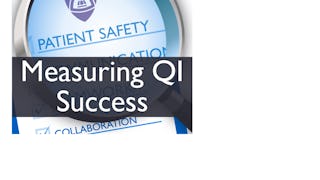Service level indicators (SLIs) and service level objectives (SLOs) are fundamental tools for measuring and managing reliability. In this course, students learn approaches for devising appropriate SLIs and SLOs and managing reliability through the use of an error budget.

Enjoy unlimited growth with a year of Coursera Plus for $199 (regularly $399). Save now.

Site Reliability Engineering: Measuring and Managing Reliability

Instructor: Google Cloud Training
59,415 already enrolled
Included with
(949 reviews)
What you'll learn
How to make systems reliable
Quantifying risks to and consequences of SLOs
Understanding SLIs, SLOs and SLAs
Skills you'll gain
Details to know

Add to your LinkedIn profile
See how employees at top companies are mastering in-demand skills

There are 7 modules in this course
This module is intended to bring you up to speed on the concepts underpinning SRE, CRE, and SLOs. If you're already familiar with these concepts, you may still find new information and perspectives in this module, but it is not necessary to complete it.
What's included
11 videos1 assignment
In this module we’re going to talk about how you measure the desired reliability of a service. We will address what to consider when setting SLOs for your application within your organization. We'll look at the three principles we use to measure the desired reliability of a service: figuring out what you want to promise and to whom, figuring out the metrics you care about that make your service reliability “good", and finally, deciding how much reliability is good enough.
What's included
7 videos4 assignments
In this module, we’ll start by introducing a mechanism for quantifying unreliability using something called an error budget. We'll show how error budgets help you decide when to focus on making a service more reliable. And then we'll learn about some of the engineering and operational improvements that can help you do that.
What's included
7 videos3 assignments
In this module we will start off by taking a look at some characteristics of monitoring metrics that can make them useful as SLIs and contrast these against other metrics that are less useful. Because the choice of where to measure an SLI is a key variable, we'll cover the five main ways you can measure an SLI and compare their pros and cons.
What's included
14 videos3 assignments5 discussion prompts
In this module, we'll start off with an overview of our four step process for developing SLOs and SLIs for a user journey. We'll introduce the fictional company that created our example mobile game, the infrastructure that we'll be working with, and the simple user journey we'll be applying the four step process to.
What's included
7 videos2 assignments2 peer reviews
In this module we'll be taking a critical look at the availability risks for our example service. We want to answer the question: "are our SLO targets and error budgets realistic?"
What's included
4 videos2 peer reviews
In this module, we'll cover best practices for documenting your SLOs, the rationale behind a formal error budget policy and how best to create one and finally, we'll look at an example error budget policy in order to understand the trade-offs and incentives that play out during negotiations when trying to write an error budget policy.
What's included
9 videos3 assignments3 discussion prompts
Instructor

Offered by
Explore more from Cloud Computing
 Status: Free Trial
Status: Free TrialGoogle Cloud
 Status: Preview
Status: Preview Status: Free Trial
Status: Free TrialJohns Hopkins University
 Status: Preview
Status: PreviewBoard Infinity
Why people choose Coursera for their career




Learner reviews
949 reviews
- 5 stars
69.86%
- 4 stars
20.75%
- 3 stars
5.26%
- 2 stars
2.21%
- 1 star
1.89%
Showing 3 of 949
Reviewed on May 27, 2020
This course is top notch. I highly recommend this course for those who wants to learn about the fundamentals of sli, slo and error budgets and policy.
Reviewed on Jun 7, 2020
The Couse was very good and informative . Only improvement needed I think should be the quality of the recording . It was very fast in some instance and voice quality was distorted
Reviewed on Mar 28, 2021
Great course, exercises and peer reviews were a challenge... easy to get off track and difficult to get back aligned.. need better level setting on expectations of submissions.
Frequently asked questions
To access the course materials, assignments and to earn a Certificate, you will need to purchase the Certificate experience when you enroll in a course. You can try a Free Trial instead, or apply for Financial Aid. The course may offer 'Full Course, No Certificate' instead. This option lets you see all course materials, submit required assessments, and get a final grade. This also means that you will not be able to purchase a Certificate experience.
When you purchase a Certificate you get access to all course materials, including graded assignments. Upon completing the course, your electronic Certificate will be added to your Accomplishments page - from there, you can print your Certificate or add it to your LinkedIn profile.
Yes. In select learning programs, you can apply for financial aid or a scholarship if you can’t afford the enrollment fee. If fin aid or scholarship is available for your learning program selection, you’ll find a link to apply on the description page.
More questions
Financial aid available,
¹ Some assignments in this course are AI-graded. For these assignments, your data will be used in accordance with Coursera's Privacy Notice.





